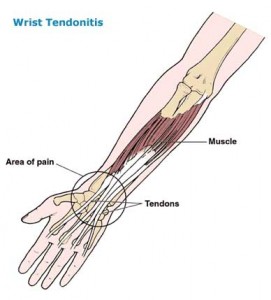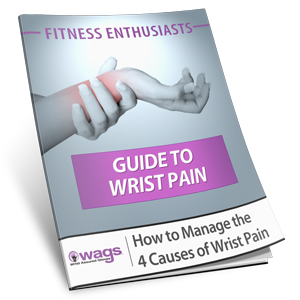Weekend Warrior Syndrome
Has the sunshine beckoned you outside to play? Are you feeling the effects of being overzealous in your exercising? You may have Tendinitis which is commonly caused from over doing it – too much, too soon. ‘Weekend warriors’, people that exercise hard, primarily on the weekends, are prone to tendinitis. Jumping into tennis and golf games in the spring after a winter off or engaging in an overly rigorous weight lifting routine will lead to tendinitis.
Catching tendinitis early is the key to treating it effectively! But you can also avoid the nagging pain of tendinitis. With some conditioning and a few precautions you can exercise and enjoy your favorite summer activities without tendinitis flaring up.
What makes up a tendon? A tendon is a band of tough, fibrous connective tissues that attaches the muscles to the bones. The attachment site of the tendon on the bone is pulled during muscle contractions and movements. Micro tears in the tendon cause irritation and inflammation impairing the normal smooth gliding motion of the tendon. This inflammation is known as Tendinitis. It’s commonly caused by minor stress and repetitive motion, but can also occur from sudden serious impact or injury. This article focuses on overuse or repetitive motion –doing too much too soon.
Top 3 Causes of Tendonitis
1. Repetitive Strain on the Tendon
Repetitive strain is the most common cause of tendinitis. When you perform the same motion over and over again, often with force added, tendinitis results. Athletes and musicians are prone to tendinitis from the repetitive movements performed in their rigorous practice schedules. People that work on assembly lines or do other work related repetitive motions are susceptible to tendinitis. Weekend warriors as well as enthusiastic fitness buffs can end up with tendinitis by simply over doing it.
2. Adding Stress to the Tendon
Lifting a heavy load repeatedly puts the tendon under strain causes tendinitis. This is common among bodybuilders, especially if they do not properly warm up, use incorrect form or training techniques. Kettle bell exercises can combine momentum with a heavy load. This can easily result in overstretching at the end range of motion, stressing or even tearing tendons. Supporting body weight on the hands repeatedly, such as in vinyasa flow yoga can stress the tendons of the wrist.
3. Being a Boomer
Tendons gradually lose their elasticity as we age which makes boomers more prone to tendonitis. Anyone over 40 is more susceptible to stress and tearing as the tendons start to become less pliable. With less elasticity in the tendon and less flexibility in the muscle the tendon may not move as freely, so it’s subject to strain.
Tendonitis Symptoms
The most common symptom of tendinitis is pain at the site of the tendon and surrounding area. Stiffness or tightness can also accompany the pain. The pain usually intensify’s when the tendon is under stress, such as in a pitcher throwing a fast ball. If left untreated tendinitis may progress and the pain can be severe. If the pain is sudden and intense, this can be an indication of a more severe injury to the tendon, such as a tear. Progression of Symptoms:
1. Slight pain during or just following a work out, tennis game or an activity where tendon is under pressure.
2. Pain persists after a day or two of rest even when there is no pressure or resistance to the tendon. There is pain and stiffness with joint movement and range of motion may be restricted.
3. Pain intensifies to a burning sensation around the affected area, especially during or after exercise or work tasks when the tendon is under strain.
4. Swelling, redness and warmth in the affected area are a sign fluid is accumulating along the tendon sheath and the tendonitis has become serious.
Common Places for Tendonitis
Because tendons are present throughout the body, tendonitis can develop anywhere a tendon connects to bone. The most common sites are-
- Base of the Thumb
- Wrist
- Elbow
- Shoulder
- Hip
- Knee
- Achilles tendon
 Avoiding Tendonitis
Avoiding Tendonitis
Want to learn more about how to prevent tendonitis? Preventing tendonitis is much easier then treating it, so a little common sense can go a long way. Apply these suggestions not only to your exercise routine and sports, but to work and leisure activities too.
- Take it Slow: Gradually build up your activity level and ease into sports, exercise and weight lifting especially if you’ve been less active for a period of time. Gradually build up your strength and endurance.
- Warm Up: Always warm up before an activity, especially a strenuous one. Move around for a minimum of 5 minutes lightly moving and exercising the arms, legs and torso. Lift light weights to warm up before attempting heavy lifting. Putting stress on the tendons and joints without warming up first will aggravate the tendons and quickly lead to tendinitis.
- Gently Stretch: Gently stretch muscles and tendons prior to activity and exercise. A tight muscle will naturally exert more pull on the tendon and insertion. Hold each stretch for 20 -30 seconds. Do not bounce. Stretch again following a strenuous activity or exercise. Also increase or maintain flexibility through yoga, Pilates, Tai Chi and other mind body disciplines can help keep injuries at bay.
- Limit Repetitions and Forceful Motions. Yoga classes with 20+ repetitions of sun salutations put unnecessary strain on the wrist (unless of course you’re wearing Wrist Assured Gloves) Playing an intense tennis game for 2 hours without being conditioned for it can lead to tennis elbow.
- Strengthen Tendons & Balance Muscles. Light resistance and weight training to improve your muscle and tendon strength is beneficial. Often one muscle group may be stronger, which can add stress to the joints. Work with a knowledgeable trainer to set up a series of exercises for each muscle group. General guidelines are 3 sets of 10 – 20 repetitions of each exercise 3 times per week. Again, gradually build up and don’t overdo it.
- Don’t Ignore Pain. Respect your body’s warning system and pay attention to pain. When you feel pain in your tendons or joints this may be a sign that they’re under too much strain or pressure. Give it a rest or stop the exercise or activity completely. Don’t push through pain.
- Modify the Joint Position or Exercise. Avoiding or modifying an activity that causes tendon and joint pain is a proactive way to avoid developing tendonitis. For example if you are doing a plank and have pain in your wrists when putting weight on your hands, modify the position of the wrist by wearing the WAGs workout gloves with wrist support or using a prop like push-up bars. Alternatively, you can do a plank on your elbows to completely avoid pressure on the wrist tendons. Soft joint supports that provide mild compression and keep the joint warm can also be helpful.
So go ahead and get active. Just follow these 7 tips to help you avoid tendinitis. Recognize early that tendinitis is developing and take positive steps towards prevention. It’s easy to ignore mild pain, but this is the first warning sign. Most importantly, allow the tendon to rest. Consult with your health practitioner early on before the tendinitis progresses from mild to severe. …Or else you’ll be sitting in the golf cart or the court sidelines cheering on your pals! Wrist Assured Gloves will definitely help your thumbs and wrists! Try a pair today, you’ll be glad you did.








Thank you for the article on Tendonilis. I suffer from this. Have stopped my activity (yoga) and modified it. Now back doing it. I have the shoulder problem when I do planks etc. Have used your gloves for a few years and that has really help.
Question: Does this ever go away completely?
Yes, it does, but depending upon the severity it may takes a LONG time. Complete rest and avoidance of the activities that aggravate it is important for healing, but difficult to do. Glad the WAGs are helping you! Good luck.
Thanks for the article. Not a wrist enquiry – but after dinghy (small boat) sailing (crouching down and moving around!) – at the w/e and after a 3-4 week break, I get really sore tendons (I presume) at Hips and above knees. This has happened 4 or 5 times now. I am 56. Would this be tendonitis and if so it would seem that an aerobic and muscle warm up and some serious stretches before exercise would be the best option?
Many thanks
David
David – Glad you found the article beneficial. We’re not in the position to give specific advise regarding your situation
as many variables can come into play with pain. It’s possible your hips may be sore from the constant flexion required to crouch down
and the pain above the knees could be your quads complaining about that same squat position. When you’re squatting if your knee goes forward to far (so you cannot see toes) this is stressful on the joint. Stretching your quads and hips extensors following your sail
may be helpful, as well as strengthening your legs and hips to prepare for this position. Warm ups and stretching before exercise is always a good idea
whether you have tendinitis or not.
I think it is essential to perform isokinetic eccentric exercises to achieve a correct tolerance of the tendon in sports activities.
What do you do when it is in your foot?
Take the same steps to avoid stressing your foot. Relax it and ice it too. If you can modify what you’re doing that aggravates it that’s recommended. What part of your foot and what’s causing it?
The top of my foot and he said the cause is over use
I have a sharp pain at my elbow, because I’ve been lifting heavy weight constantly and it has affected my tendon, which caused it to swell and is so painful. I need advice on how to recover and start lifting weights.
Thank you.
Ice your arm several times a day and stop lifting while your tendon heals, then start back gradually probably with reduced weights. Lift with good form, stretch when your finished and only lift 3 to 4 times a week with a day of rest in between. Good Luck!
Hi there, I’ve been suffering from joint pain for a long time. I started in a gym and my elbows had pain. Changed to swimming and after a while I had shoulder pains. Switched to cycling and my knees and elbows where again with pain. Even yoga gave me problems.
What I have seen is that my body has a tendency to joint or tendons pain with any physical activity and I hate it! Is there something you can recommend? I’m 35 btw
Jorge- It’s difficult to give advice without seeing you, but it sounds like you have tried a lot of activities – which each resulted in pain. First question is do you have low muscle tone or hypermobility in the joints? When you have pain how severe is it on a scale of 1-10 with 10 being severe? At 35 y.o. it’s likely not “wear and tear” arthritis, but you say your joints hurt. Is the pain IN your joints or do you feel it elsewhere too? Here are some general guidelines: Gently stretch before you workout and stretch more deeply after you’ve finished. Use lighter weights, instead of heavy weights. Pay attention to your form – make sure your joints are aligned properly when doing an activity. A personal trainer could be a great resource. If you haven’t seen a doctor or other professional it might be a good idea to go get checked out and rule out Rheumatoid Arthritis and other things. Good Luck!
You previously asked about hypermobility, are people with hypermobile joints more susceptible to tendinitis?
I have hypermobility and I have been suffering with pain in my knees after weight lifting and performing squats.
Hypermobility can lead to tendonitis – because a) when the muscles are weak more stress is on the tendons b) more importantly when your working out and moving about your day, try not to let the hypermobile joint extend all the way. The stress this adds to the tendon over time will likely cause tendonitis. When your doing squats focus on your form – don’t go down as far into flexion and try to stop when standing up before your knees are fully extended. Good Luck!
I don’t know if it is tendonitis or not but i have a pain that comes and goes in the other side of the forearm.
The pain is not that severe and only last for 2 seconds and again comes after sometime.
I had been lifting weights but now i am on rest for two days.
Is it symptoms of tendonitis?
It could be tendonitis. I’m not clear where you’re feeling the pain, but it’s good that it only last a few seconds. When you’re weight lifting make sure your weights aren’t too heavy and that you stretch after. Good Luck!
Yesterday i had pain just above the elbow then i applied ice on it now there is no in in that region but sometimes i feel the pain in my forearm
I am also cunfused at the exact location of the pain ase sonetimes pain is below the elbow and some times it is near the wrist
Should i continue lifting with light weights?
I have done excessive abs and packs exercise for two weeks and then I start feeling that i have pain in centre of chest. The pain only seems when I twist my body or sleeping on the right side down. It’s about one and half month but the pain has not gone completely. Please suggest something to me.
It’s difficult to say based on the little I know. You might have pulled a muscle. If you’re noticing less pain in a month and a half you’re probably getting better. You can ice it and gently stretch, but I’d talk to a personal trainer at your gym.
Really enjoyed this article.
I’m glad you found it beneficial Sally!
My right shoulder is in pain right now. Three years ago the doctor said i have tendonitis. Pls advise me. Thank you for this article
Without knowing more about your shoulder I really can’t diagnose it. Tendonitis can come and go, so it might still be tendonitis. The best thing is ice it a couple times a day and use a pain relief cream. Figure out what your doing that aggravates it, then modify that or completely rest your shoulder for several weeks and see if it’s getting better. You could go to an orthopedic doctor if it’s still bothering you to get a diagnosis. Good Luck!
Hi Paula, loved your article. I have been having pain in my shoulder and the top of shoulder and arm on my left side. I was pretty overweight went on a big health kick. Dropped 35 pounds, quit smoking and drinking, started doing 30 minutes a day on my eliptical and free weights. Two days on and one day off. This went on for about a month and three weeks. I was feeling so great and getting even more into it. I would do a series of sets for my upper body with 5 and 8 pound weights and a 15 pound kettleball which I incorporated with arms and squats. Anyways!! I thought I was doing so well I could up my weight. So bought 10 pound weights. Just two freaking pounds up! But I was doing the exercise when you have the weight at the side of your body and left is out to the side (if that makes sense) and I felt a pain in my left shoulder and stopped. Waited a couple days and didn’t go away so went to my chiropractor for four weeks. I now have range of motion problems. I can lift my arm up no problem to the ceiling no pain but from the side of my body going back, like a big loop, it doesn’t go, long story short, I had xrays, which showed nothing and I’ve been referred to get more tests, but could take a month!! Ugh.. and I would really like to lift at least something to keep what I started… could this be tendonitis? And could I lift just a light amount? Or just seriously complete rest? Thanks, sorry about the long winded story lol
Well I’m sorry to hear you’ve had a set back. It’s difficult for me to know if it’s tendonitis or something else. But if you have pain when bringing your arm down you should rest it for 3-6 weeks and avoid the movements that cause you pain.
You could still lift weights on the right side with single weights not a barbell. You’re free to do all of the other stuff too – legs, core, aerobics. I’m sure you want to keep your progress going! After you’ve rested your left arm start with very light weights and see how it feels. Best of luck to you!
It is on the top of my foot by my big toe and really hurts when I touch the area on the side of my big toe. How do you do stretches before walking the treadmill in that area?
It may not be tendonitis – you could of bump your foot or toe causing an impact soreness. You can try pushing your toe sideways (toward little toe) and see if that hurts or helps.
Good Luck!
Love this post! Thanks so much for sharing it 🙂
I was having a problem with my right wrist clicking and swollen tendons in right wrist. I have been exercising for over 40 years and lifting weights now at 65 I have a problem. I saw a hand specialist and he gave me two cortisone shots and all was well for a few months. Now whenever I try to lift weights it seems like my joints in right wrist swell up and the skin on my wrist changed colors. Do you know what is going on
Terri- Have you tried any type of a wrist support on your right hand? It sounds like you might benefit from one – either the compression type (you can still move your wrist) or one that stabilizes your wrist completely. Good luck!
Interesting replies by others😀, however mine is difinatley in the right wrist as per your illustration. Been a active 60 year old and doing weight training etc. I assume injuries will be part of any type of exercise or sport. I have been lucky so far! Keep excercising and never stop. All the best Patrick
I’m am 64 years old. For two months now, I’ve had had tendonitis in both my wrists (mainly my right wrist as I’m right-handed) and my elbows. It started when I was doing my usual workout on a weight machine at my health club.
For the first week or two I thought I could just tolerate the pain by using lighter weights, but the pain persisted. Also, I found my wrists and elbows would ache when I got out of bed in the morning. I tried using wrist braces to sleep with a night, but I found they made the pain worse in the morning.
Every so often, I’ve been wrapping ice pads around my wrists. I also do massage and take ibuprofen. But the pain, which is normally somewhat mild, is still there.
I’ve just read somewhere else that resting entirely is not a good idea, that you start rehabilitation with very light weights and continue from there. I also read that ice and massage are not good for long-term healing.
I’m not ready to be an old man. I would deeply appreciate your advice. Thank you.
Best,
Tony Laudati
Tony- You might try a compression wrap for your wrists. That would help with swelling and the compression feels good and allows for movement, which is important. The massage (electric or manual) is good. There’s no hard rules for tendonitis, as it depends on the severity and the pain -is it all the time, during resisted movements or ocassionally at rest. Use your pain as a guide and it sounds like you’ve made good progress. Ice is good, but you don’t want to do it several times a day for a long time. Alternating ice and heat can be effective if you’re really swollen and in a lot of pain. If you haven’t been lifting definitely start with light weights and see how your body responds and build up from there, as your body allows. Best of luck to you!